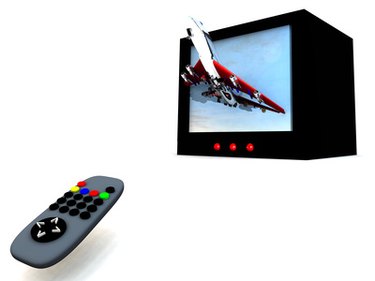
Researcher A.C. Nielsen estimates that Americans watch, on average, the equivalent of two months of television per year. His research indicates that 99 percent of families now own a television set. The concept of TV originated in the 1880s when Paul Nipkow patented the basic idea of using photoelectric cells and light beams to create an image. The first television set was then invented in the 1920s. Today, TV sets are more sophisticated and constructed in a more streamlined way; however, the basic components remain the same.
Cathode Ray Tube
Video of the Day
A cathode ray tube enables an image to be seen on the screen of the television. It works by sending out a beam of electrons which then land on the TV screen and create a visual display.
Video of the Day
Light Valve
The light valve works in conjunction with the cathode ray tube. It provides a fixed source of light that essentially lights up the electrons from the cathode ray tube so that they can be seen on the screen. Light valves have improved in quality as technology has advanced. High-definition TVs provide clearer and brighter pictures as a result of more sophisticated light valves.
Logic Board
The electrical wiring within a TV set consists of transformers, coils, chokes and resistors. These components are secured on a logic board. The circuit provides the correct electrical supply and sends messages to the various components of the TV set. It is the brain of the TV and enables it to function.
Capacitors
A capacitor is a device that stores an electrical charge between two metal plates and releases the energy as light. The capacitor in a TV set would give you a severe electrical shock if you touched it because it stores a large amount of power.
Screen and Surround
The most obvious components of a TV are the ones you can see. These are the screen and the TV surround. The material the screen is made from varies. Traditional screens were made from glass; however, more modern units, such as LCD and plasma screens, are made from plastic. The surround of the TV is the outer shell which protects the internal components of the TV listed previously. This shell is usually made of a durable plastic.
- California State University: Television and Health
- Idea Finder: Television History
- Old Technology: TV Components
- Television - Operation Of The Cathode Ray Tube Read more: Television - Operation Of The Cathode Ray Tube
- Google Books: Television Receivers
- Physics.edu: Capacitors
- TV History: History of TV
- Best Buy: Televisions